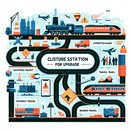
The European Commission on 14 November presented an ambitious action plan to halve rail journey times between major EU cities by 2040, calling high-speed trains the backbone of a climate-neutral transport network. Speaking in Rome, Transport Commissioner Apostolos Tzitzikostas highlighted Berlin-to-Copenhagen in four hours and Munich-to-Rome in six as showcase targets. Brussels estimates the programme will require at least €345 billion in new or upgraded track and rolling stock, rising above €500 billion by 2050.
Germany—geographically central and already home to over 1,700 km of high-speed lines—will be pivotal to the scheme, yet its rail operator Deutsche Bahn faces criticism over delays, staffing shortages and ageing infrastructure. The Commission’s blueprint therefore pairs infrastructure funding with regulatory reforms: harmonised ticketing, open-access competition and fast-track permitting for cross-border projects. A legal proposal on through-ticketing is due in early 2026 and could break the technological deadlock that currently prevents seamless Berlin–Paris bookings.
![EU Unveils High-Speed Rail Action Plan—Germany Cast as Crucial Yet Troubled Hub]()
For corporate mobility managers, the plan signals a future in which intra-EU business trips under 1,000 km shift from air to rail. German firms with sustainability pledges—especially in consulting, finance and tech—could trim Scope 3 emissions by routing employees via the expanded rail grid. Yet the short-term reality is likely more disruption: construction work on the Stuttgart–Ulm–Augsburg corridor and the Frankfurt node upgrade will tighten capacity over the next five years.
Lufthansa, meanwhile, is negotiating with the German transport ministry on ‘rail-air codeshare’ obligations that would see feeder flights between Frankfurt and Düsseldorf replaced by high-speed rail once journey times fall below two hours. Analysts say the 2040 network could reduce domestic German flights by up to 45 percent.
Small and medium-sized enterprises should monitor grants under the Connecting Europe Facility, which will partly subsidise digital ticket-integration pilots and corporate rail passes. The Commission also flagged Germany’s dormant Autobahn tolling company Toll Collect as a potential data platform for dynamic track-pricing—hinting that German industry will shape Europe’s smart-rail back-office.
Germany—geographically central and already home to over 1,700 km of high-speed lines—will be pivotal to the scheme, yet its rail operator Deutsche Bahn faces criticism over delays, staffing shortages and ageing infrastructure. The Commission’s blueprint therefore pairs infrastructure funding with regulatory reforms: harmonised ticketing, open-access competition and fast-track permitting for cross-border projects. A legal proposal on through-ticketing is due in early 2026 and could break the technological deadlock that currently prevents seamless Berlin–Paris bookings.

For corporate mobility managers, the plan signals a future in which intra-EU business trips under 1,000 km shift from air to rail. German firms with sustainability pledges—especially in consulting, finance and tech—could trim Scope 3 emissions by routing employees via the expanded rail grid. Yet the short-term reality is likely more disruption: construction work on the Stuttgart–Ulm–Augsburg corridor and the Frankfurt node upgrade will tighten capacity over the next five years.
Lufthansa, meanwhile, is negotiating with the German transport ministry on ‘rail-air codeshare’ obligations that would see feeder flights between Frankfurt and Düsseldorf replaced by high-speed rail once journey times fall below two hours. Analysts say the 2040 network could reduce domestic German flights by up to 45 percent.
Small and medium-sized enterprises should monitor grants under the Connecting Europe Facility, which will partly subsidise digital ticket-integration pilots and corporate rail passes. The Commission also flagged Germany’s dormant Autobahn tolling company Toll Collect as a potential data platform for dynamic track-pricing—hinting that German industry will shape Europe’s smart-rail back-office.





